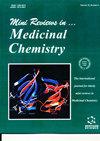芦荟大黄素:药理活性、安全性和药物制剂应用方面的进展
IF 3.3
3区 医学
Q2 CHEMISTRY, MEDICINAL
引用次数: 0
摘要
:芦荟大黄素(AE)是一种蒽醌衍生物,是从大黄和芦荟等多种植物中提取的生物活性成分。AE 的化学名称为 1,8-二羟基-3-羟甲基-蒽醌,在传统医学中有着悠久的历史,因其易得性、安全性、经济性和有效性而备受推崇。AE 具有多种生化和药理特性,如强大的抗菌、抗氧化和抗肿瘤作用。尽管 AE 具有一系列优点,但其蒽醌衍生物的特性使人们担心它可能会对肝脏和肾脏产生毒性。然而,AE 因其显著的生物活性和成本效益而被认为是一种很有前途的候选药物。最近的研究强调,纳米制剂 AE 可增强药物输送、生物相容性和药理作用,为药物设计提供了一种新方法。本综述深入探讨了 AE 的药理作用、机制、药代动力学和安全性,并纳入了对其纳米制剂研究的见解。其目的是概述该领域的新兴研究,并为基于 AE 的疗法的持续开发和利用提供支持。本文章由计算机程序翻译,如有差异,请以英文原文为准。
Aloe-emodin: Progress in Pharmacological Activity, Safety, and Pharmaceutical Formulation Applications
: Aloe-emodin (AE) is an anthraquinone derivative and a biologically active component sourced from various plants, including Rheum palmatum L. and Aloe vera. Known chemically as 1,8-dihydroxy-3-hydroxymethyl-anthraquinone, AE has a rich history in traditional medicine and is esteemed for its accessibility, safety, affordability, and effectiveness. AE boasts multiple biochemical and pharmacological properties, such as strong antibacterial, antioxidant, and antitumor effects. Despite its array of benefits, AE's identity as an anthraquinone derivative raises concerns about its potential for liver and kidney toxicity. Nevertheless, AE is considered a promising drug candidate due to its significant bioactivities and cost efficiency. Recent research has highlighted that nanoformulated AE may enhance drug delivery, biocompatibility, and pharmacological benefits, offering a novel approach to drug design. This review delves into AE's pharmacological impacts, mechanisms, pharmacokinetics, and safety profile, incorporating insights from studies on its nanoformulations. The goal is to outline the burgeoning research in this area and to support the ongoing development and utilization of AE-based therapies.
求助全文
通过发布文献求助,成功后即可免费获取论文全文。
去求助
来源期刊
CiteScore
7.80
自引率
0.00%
发文量
231
审稿时长
6 months
期刊介绍:
The aim of Mini-Reviews in Medicinal Chemistry is to publish short reviews on the important recent developments in medicinal chemistry and allied disciplines.
Mini-Reviews in Medicinal Chemistry covers all areas of medicinal chemistry including developments in rational drug design, synthetic chemistry, bioorganic chemistry, high-throughput screening, combinatorial chemistry, drug targets, and natural product research and structure-activity relationship studies.
Mini-Reviews in Medicinal Chemistry is an essential journal for every medicinal and pharmaceutical chemist who wishes to be kept informed and up-to-date with the latest and most important developments.

 求助内容:
求助内容: 应助结果提醒方式:
应助结果提醒方式:


